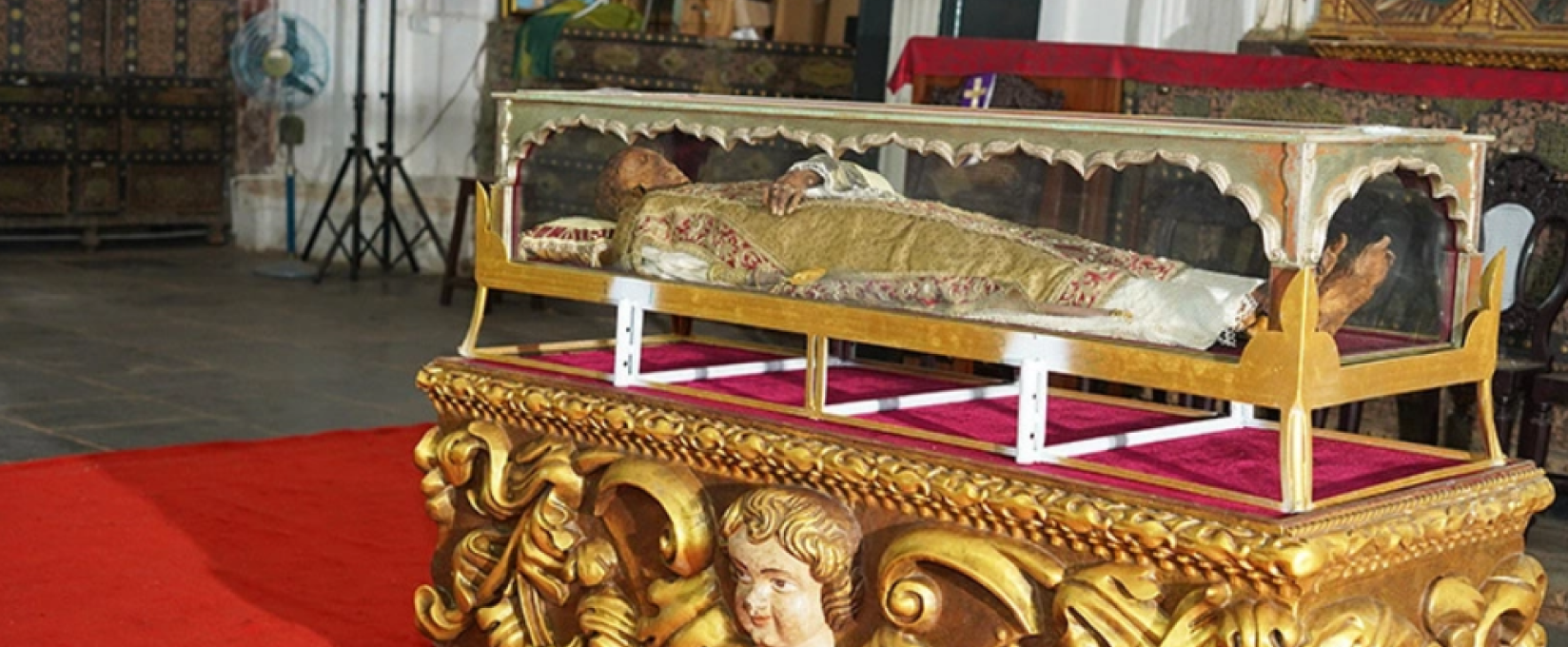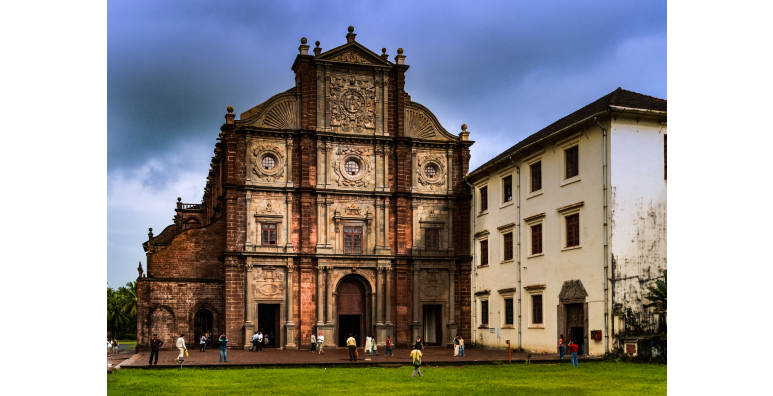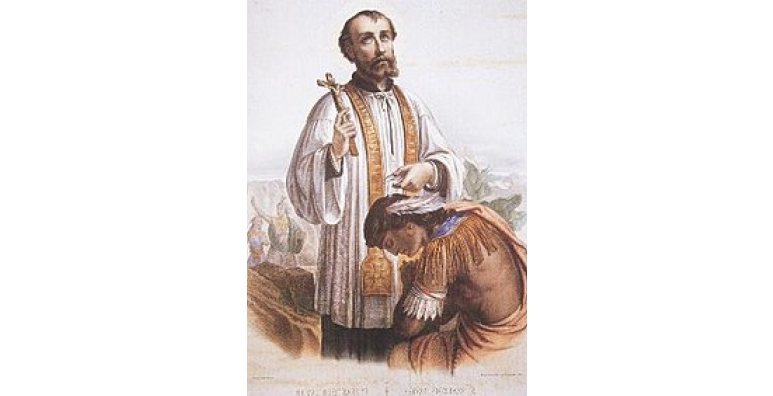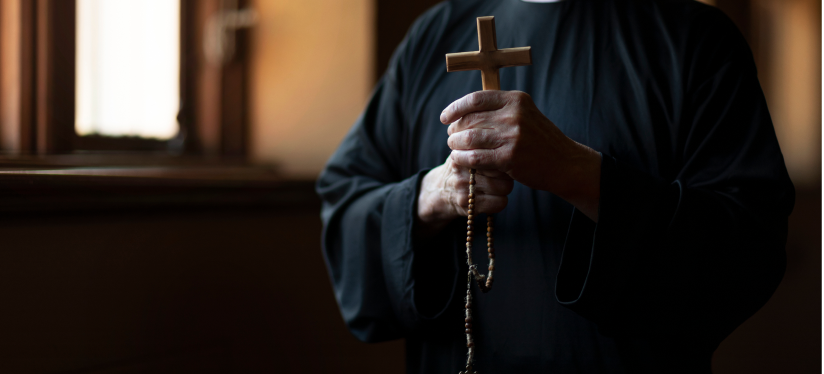
In conformity with the long-standing practice, followed in the Archdiocese of Goa and Daman, of holding the Solemn Exposition of the Sacred Relics of St. Francis Xavier every ten years, the 18th Exposition of the Sacred Relics of “Goycho Saib” will begin on 21 November 2024 and will end on 05 January 2025. On 21 November, the Solemn Eucharist for the opening of the Exposition will be at 9:30 a.m., after which the Sacred Relics of the Saint will be taken in a Solemn Procession to the Se Cathedral Church. The Sacred Relics will be kept in the See Cathedral Church for veneration by the devotees for 45 days. On 05 January 2025, the Sacred Relics of the Saint will be taken back to the Basilica in a Solemn Procession which will begin at 9:30 a.m. and will be followed by the Solemn Eucharist for the closing of the Exposition. The Church in Goa and Daman, along with the Universal Church is preparing for the Jubilee Year 2025 and the Theme chosen by Pope Francis for this spiritual event is, “Pilgrims of Hope”. The Theme chosen for the Solemn Exposition is, “Xubhvortomanache Porgottnnar ami”, “We are Messengers of the Good News”. A special Logo has been designed for the event. The Theme and the Logo focus on the responsibility of every Christian in spreading the message of Love, Hope and Peace to the four corners of the world. A special “Prayer”, to be prayed every day by individuals, by families in their homes, in Churches, Chapels, Small Christian Communities, etc., has been prepared. The Exposition Committee urges every faithful and all people of good will to pray that the twin celebrations may bring about a renewal of Christian life and help in spreading peace and harmony among all. During this year of preparation, Priests are urged to organise pilgrimages with their parishioners, especially with Catechism children and youth, to the City of Old Goa. An Art Exhibition on St. Francis Xavier will be put up during the Exposition. Prominent artists from Goa and India have been invited to contribute. A Souvenir in the form of a Book, on the life story of St. Francis Xavier, as depicted beautifully on the Silver Casket in which the Sacred Relics of the Saint are kept, will be released on the occasion of the Exposition.

The Exposition of the Sacred Relics of St. Francis Xavier is a momentous event held in Old Goa, Goa, every ten years, attracting pilgrims and tourists from around the world. This significant religious celebration honours St. Francis Xavier, a revered Spanish missionary and co-founder of the Society of Jesus (Jesuits). Known for his extensive missionary work across Asia, St. Francis Xavier is venerated for his dedication to spreading Christianity and his enduring spiritual legacy. During the exposition, the sacred relics of St. Francis Xavier, normally housed in the Basilica of Bom Jesus, are displayed for public veneration in the Sé Catedral. The event spans several weeks and includes a variety of religious ceremonies, including Masses, prayer services, novenas and processions. It is a time of deep spiritual reflection, devotion, and celebration, highlighting the rich cultural and religious heritage of Goa.

After Saint Francis Xavier's death on December 3, 1552, on the island of Shangchuan off the coast of China, his body was initially buried there in a simple grave. Recognizing the saint’s significance and the risk of his remains being disturbed, his body was exhumed in February 1553 and transported to Malacca. In Malacca, his body was temporarily housed in the Church of St. Paul, where it remained for several months. During this time, the body was observed to be remarkably well-preserved. In December 1553, the decision was made to move the body to Goa, India, which was a significant center for the Jesuit missions. Upon arrival in Goa in early 1554, his body was enshrined in the Basilica of Bom Jesus.
Remarkably, his body remained incorruptible, showing minimal signs of decay even after years. This phenomenon, considered by many to be a sign of his sanctity, attracted countless pilgrims. The relics are displayed for veneration every ten years, Housed in a glass container for the devotees to have a clear view. Additionally, one of his notable relics, his right arm, which he used to baptize many, is enshrined separately in the Church of the Gesù in Rome. The preservation and veneration of Saint Francis Xavier’s relics continue to inspire devotion and wonder among the faithful, drawing pilgrims from around the world to honor his legacy and seek his intercession.
St. Francis Xavier, born on April 7, 1506, in the Kingdom of Navarre (present-day Spain), is one of the most renowned missionaries in Christian history. He was educated at the University of Paris, where he met Ignatius of Loyola and became one of the first members of the Society of Jesus (Jesuits).
Early Life and Education

Francis Xavier was born into a noble family at the Castle of Xavier in Navarre. As a young man, he showed great intellectual promise and was sent to study at the University of Paris. It was there that he encountered Ignatius of Loyola, whose vision and spiritual fervor deeply influenced him. Initially, Francis was more interested in academic success and personal ambition, but Ignatius's persistent encouragement led him to a life of deeper spiritual commitment.
Formation and Ordination
In 1534, Francis Xavier, along with Ignatius of Loyola and five other companions, took vows of poverty, chastity, and obedience, including a vow to go to the Holy Land or to serve the Pope if that was not possible. This group became the nucleus of what would later be the Society of Jesus, commonly known as the Jesuits. Francis was ordained a priest in Venice, Italy, in 1537. Following his ordination, he spent time in Rome helping to establish the Jesuit order. His missionary zeal was evident, and he soon volunteered for a mission to the Portuguese colonies in the East.
Missionary Work and Visits to Goa

In 1541, Francis Xavier embarked on a missionary journey to Asia, beginning in India. He arrived in Goa, which was then a Portuguese colony, in 1542. Goa became the central base for his missionary activities. During his time in Goa, he dedicated himself to ministering to the local population, including the Portuguese settlers and the native Goans. He established several schools and churches, focusing on the education and in building faith of both children and adults. St. Francis Xavier's work in Goa was marked by his tireless efforts to improve the moral and spiritual lives of the people. He was known for his compassion and his ability to connect with people from all walks of life. His success in Goa set the stage for his further missionary journeys across Asia.
Further Missionary Journeys

After catering to the Christian community in Goa, St. Francis Xavier expanded his mission to other regions. He traveled to the Malay Archipelago, where he preached to many about Christianity. In 1549, he embarked on a mission to Japan, where he spent two years laying the groundwork for future Christian missions. His work in Japan was pioneering, as he introduced Christianity to a country previously unfamiliar with the religion.
Death and Legacy
St. Francis Xavier's final missionary goal was to enter China, a country he believed held great potential for Christian faith. In 1552, he set out for China but fell ill while waiting on the island of Shangchuan, off the coast of Guangdong Province. Despite his illness, he remained committed to his mission, but he succumbed to fever on December 3, 1552. His death occurred in relative isolation, far from the Christian communities he had nurtured.
Initially buried on Shangchuan Island, his body was later moved to Malacca and then to Goa. Remarkably, his body was found to be incorrupt, which further fueled the veneration of the saint. Today, his relics are enshrined in the Basilica of Bom Jesus in Old Goa, where they attract countless pilgrims and tourists
Canonization and Veneration
St. Francis Xavier was canonized by Pope Gregory XV on March 12, 1622, alongside his friend Ignatius of Loyola. He is celebrated as the patron saint of missionaries and is highly venerated not only in Goa but also around the world. His feast day is observed on December 3rd. The decennial Exposition of the Sacred Relics of St. Francis Xavier in Goa is a testament to his enduring legacy. This event draws millions of pilgrims and visitors who come to venerate the saint and participate in the religious ceremonies associated with the exposition.
The Solemn Opening
The solemn opening will be on 21 November 2024. The solemn Holy Eucharist will be celebrated at 9:30 a.m. and will be followed by the procession carrying the Sacred Relics from the Basilica to the Cathedral.
Veneration
Everyday, veneration of the Sacred Relics of the Saint will be from 7 a.m. to 6 p.m. There will be no veneration on 5th January 2025.
Masses
Everyday, there will be 7 Masses in Konkani and one Mass in English. The timings are as follows: 6 am / 7.15 am / 8.30 am/ 9.45 am / 11am / 3.30 pm/ 5 pm / 6.15 pm (In English)
Special Counter For Sick, Elderly and Disabled
Wheelchair facility will be available at the gate in front of the Church of St. Francis of Assisi.
Solemn Closing
The solemn closing of the Exposition will be on 05th January 2025. The prayers in the Cathedral will begin at 9:30 a.m. and will be followed by the solemn procession. The closing holy Eucharist will follow.
The Exposition is a religious event. Please maintain the sanctity.
Silence is to be maintained at all times.
Arrive on time for religious services.
Walking is part of the pilgrimage and is a form of penance and prayer. Follow the queue system for veneration.
Please dress respectfully. Avoid immodest dressing.
Keep your mobile phones on silent mode during Mass and veneration.
Photography inside the Cathedral and of the Sacred Relics is not allowed.
Do not eat or drink while inside the Church or for religious services.
Let us care for our common home – mother Earth. Avoid use of plastics.
Use the garbage bins and keep the surroundings clean.


Lord God, our Loving Father, in the history of Salvation You call, form and send the human person.
We lift our hearts in thanksgiving to You for the divine call and mission of St. Francis Xavier.
Fixing his gaze on the Cross of Your Son, He underwent a change of heart.
Leaving aside worldly honour and with missionary zeal, he became an ardent Messenger of the Good News.
As we prepare ourselves for the Solemn Exposition of his Relics and for the Jubilee Year 2025, we implore You to strengthen our Communion by the power of the Cross; in the light of Your Word and in the true spirit of Synodality, guide our path to Participate in the Mission.
You have entrusted to us, so that, by the inspiration of the Holy Spirit, we may become joyful Messengers of the Good News. Amen.
© 2025 CATHOLIC CONNECT POWERED BY ATCONLINE LLP